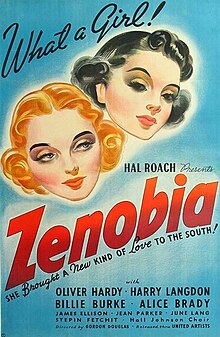Zenobia (film)
| Zenobia | |
|---|---|
 Theatrical Poster | |
| Directed by | Gordon Douglas |
| Written by | Corey Ford |
| Produced by | Hal Roach |
| Starring | Oliver Hardy Harry Langdon Billie Burke Alice Brady Hattie McDaniel |
| Cinematography | Karl Struss Norbert Brodine |
| Edited by | Bert Jordan |
| Music by | Marvin Hatley |
| Distributed by | United Artists |
Release date |
|
Running time | 73 min. 65 min (colour cut edition) |
| Country | United States |
| Language | English |
| Box office | $130,051[1] |
Zenobia (also known as Elephants Never Forget (
Plot
In 1870, Dr. Henry Tibbett, a Mississippi country doctor is called on by a travelling circus trainer to cure his sick elephant. After the doctor heals the grateful beast, the elephant becomes so attached to him that it starts to follow him everywhere. This leads to the trainer suing Dr. Tibbett for alienation of affection.
The presence of the elephant also endangers the engagement of Dr.Tibbett's daughter Mary to the son of the prominent Carter family, who are social snobs looking for an excuse to call off the wedding.
Things are resolved to everyone's satisfaction when the "male" elephant is discovered to be pregnant; and Dr.Tibbett helps deliver a healthy baby pachyderm.
Cast
- Oliver Hardy as Dr. Tibbett
- Harry Langdon as Prof. McCrackle
- Billie Burke as Mrs. Tibbett
- Alice Brady as Mrs. Carter
- James Ellison as Jeff Carter
- Jean Parker as Mary Tibbett
- June Lang as Virginia
- Olin Howland as Attorney Culpepper
- J. Farrell MacDonald as the Judge
- Stepin Fetchit as Zero
- Hattie McDaniel as Dehlia (credited as "Hattie McDaniels")
- Philip Hurlic as Zeke (Declaration of Independence)
- Hobart Cavanaugh as Mr. Dover
- Clem Bevans as the Sheriff
- Tommy Mack as the Butcher
- Robert Dudley as the Court Clerk
- The Hall Johnson Choir
- Zenobia as 'Miss Zenobia' - the Elephant
- Chester Conklin as Farmer (uncredited)
- Nigel De Brulier as Townsman (uncredited)
Background
Zenobia is one of the few films after the teaming of Laurel and Hardy that features Hardy without Stan Laurel,[3] the result of a contract dispute between Laurel and producer Hal Roach, who maintained separate contracts for each performer, rather than a team contract, which would have offered them more control over their careers. Zenobia was Roach's attempt to create a new comedic pair without Laurel, and a series of films with Hardy and Langdon was planned. The dispute was short-lived, however, and Laurel and Hardy were reunited shortly thereafter.[4]
Reception
The film performed poorly at the box office. United Artists even had trouble booking the film into theatres.[5]
The New York Times wrote on May 15, 1939, that the film:
- "...[was] a rough idea of what would happen to Gone With the Wind if Hal Roach had produced it ... an antebellum, costume romance in slapstick, in which an elephant adopts Oliver Hardy and, it appears, Harry Langdon has adopted the partnership perquisites formerly reserved for Stan Laurel."
Then—playing on the potential for a new comedy team of Hardy and Langdon—the reviewer said:
- "Harry Langdon's pale and beautifully blank countenance ... has probably already excited the professional jealousy of Mr. Laurel."[6]
In popular culture
The film is mentioned quite frequently (referred to as "the elephant movie") during the
Restoration
The 35mm nitrate stock was digitally restored, and released on dvd in 2018. Unrestored and restored comparisons of the same scenes appear side-by-side in the menu's 'Special Features'. Millions of imperfections were removed.
Music
- The music is by Marvin Hatley, the composer of "Dance of the Cuckoos", Laurel and Hardy's famous theme song.[7]
See also
- Filmography of Oliver Hardy
Notes
- ^ Ward, Richard Lewis (2005). A history of the Hal Roach Studios. Southern Illinois University Press. p. 213. - figures are producer's share from US/Canada
- ^ "SCREEN NEWS HERE AND IN HOLLYWOOD; Metro Signs von Sternberg to Direct Hedy Lamarr in Her First Vehicle for Studio HAL ROACH BUYS a STORY Producer Gets Picture Rights to 'Zenobia's Infidelity'--Roland Young to Star Coast Scripts of Local Origin". The New York Times. 2 August 1938.
- ^ For Oliver Hardy's films without Stan Laurel, see: Oliver Hardy filmography.
- ^ For details on this dispute, see the main article on Laurel and Hardy.
- ISBN 9780809327270. Retrieved 13 January 2019.
- ^ "THE SCREEN; Hardy and Langdon, With Billie Burke and Alice Brady, Are Featured in 'Zenobia' at the Globe". The New York Times. New York. 15 May 1939. Retrieved 13 January 2019.
- ^ Louvish, Simon (2001). Stan and Ollie: The Roots of Comedy: The Double Life of Laurel and Hardy, p. 267. St. Martin's Press.
